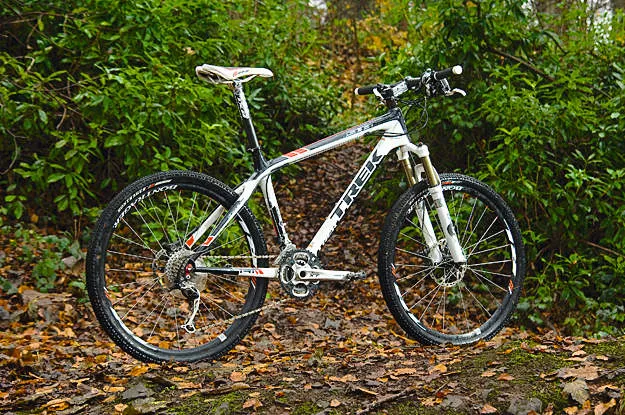Trek have been at the leading edge of carbon frame building for as long as carbon frames have been evolving. Their Optimum Compaction Low Void (OCLV) building technology has set the minimum weight and maximum strength standards for others to aim for on both road and mountain bikes, while economies of scale ensure that value for money is always to the fore on complete bike packages like this.
Ride & handling: Easy handling and instant drive power makes this an easy bike to love
Despite its long reach, the 9.8 offers a more relaxed ride feel than some pure cross-country race bikes. The slacker head angle makes for slightly easier steering on tough terrain and a low bottom bracket is a boost to stability at speed.
The downside of a low centre of gravity is the occasional pedal strike while powering through bumpy corners, and there were times on the bumps when we really wished for bigger profile tyres to soften the ride (by compressing and gripping more effectively).
That said, the Trek is an easy bike to flow through singletrack, very rapid on climbs and surprisingly easy to control on rough descents.
As it stands, the Elite 9.8 will appeal mainly to race heads. But with the more generous back sweep of a riser bar and better tyres it’s a very confident, hard-riding trail bike that should appeal to weekend warriors looking for the simple speed thrills that come with the sprightly energy of low weight and precision handling.
Frame: Quality carbon chassis; the marginally different 9.9 version costs £2,000 on its own
While the top-of-the-range US-built £5,000 Elite 9.9 SSL offers a second generation ‘no cut’ seatmast and an XTR-based racer’s parts setup, the Taiwan-built 9.8 is a tiny bit heavier but half the price. Differences between a 9.8 and a 9.9 frame are differences that only the most ardent weight fetishist will fully appreciate, with the 9.9 using a higher percentage of high modulus carbon fibre and a slightly more complex lay-up procedure.
The 9.8 is superbly finished, with swoopy sculpted lines emphasised by black, white and red panels, and ‘Trek Racing Technology’ graphics. There’s loads of mud room, two sets of bottle cage bosses and the bottom bracket is Trek’s BB90 oversized unit with press-fit bearings, which gives a noticeable boost to stiffness.
Trek’s high-performance bikes have been influenced by the long-centred Gary Fisher Genesis geometry. Our 18.5in test model has a 24in horizontal top tube reach. While fettling the saddle and handlebar positions will inevitably find your chosen ride position, the long centre, lower bottom bracket and 1° slacker head angle of the Trek might seduce those looking for that potent combination of speed and maximum stability.
Equipment: Great fork and sensible finishing kit spec, but we'd swap the tyres
The F Series Fox fork with bar-mounted lockout offers all the compression and rebound adjustment you’re likely to need, plus a well controlled 100mm of travel. A Shimano XT drivetrain and brakes are sensible slick shifting choices while the Bontrager Race Lite and Race Extra Lite componentry is all well designed, light kit that does the job.
The seatpost and flat bar are carbon, bar width is a generous 24.5in and the saddle is comfier than most, taking the hard edges off the punishment being dished out by the skinny Bontrager XR tyres (these need to be pumped up hard). The minimalist block-treaded tyres will suit summer racers but fatter rubber would add extra comfort and extra control, and consequently in many cases give a speed boost too; we regularly found ourselves right on the edge of control in the mud.

